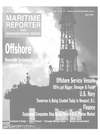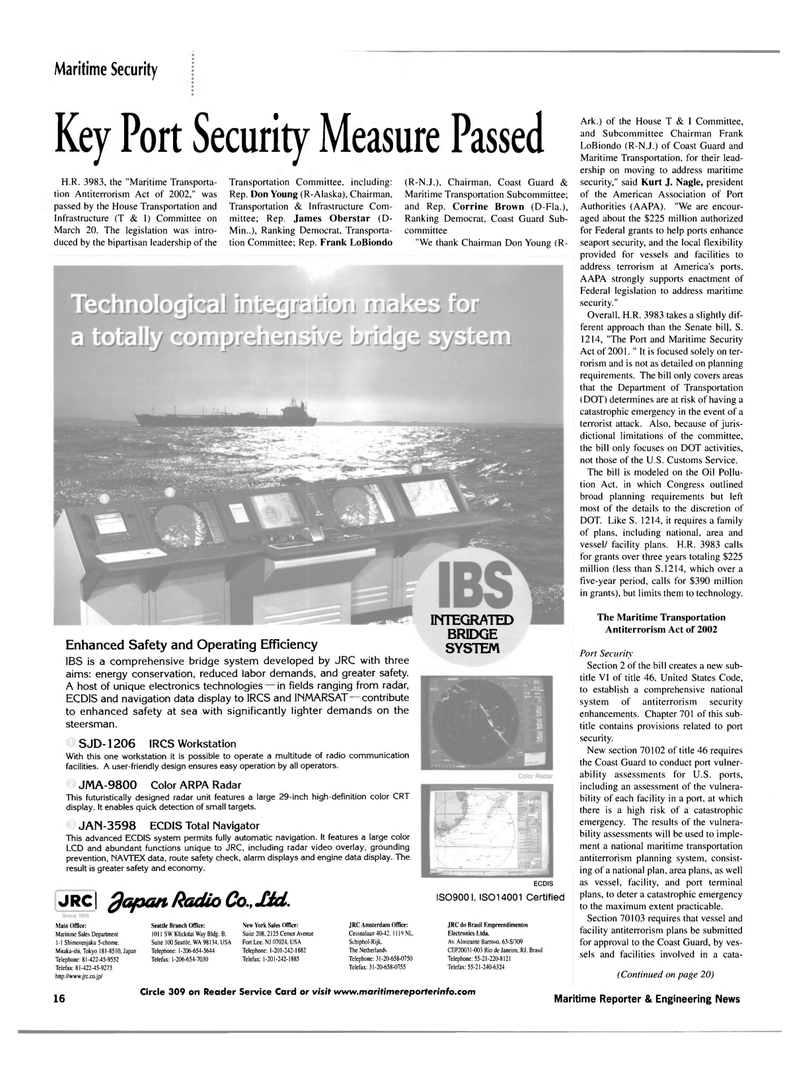
Page 14: of Maritime Reporter Magazine (April 2002)
Read this page in Pdf, Flash or Html5 edition of April 2002 Maritime Reporter Magazine
Maritime Security
Key Port Security Measure Passed
H.R. 3983, the "Maritime Transporta- tion Antiterrorism Act of 2002," was passed by the House Transportation and
Infrastructure (T & I) Committee on
March 20. The legislation was intro- duced by the bipartisan leadership of the
Transportation Committee, including:
Rep. Don Young (R-Alaska), Chairman,
Transportation & Infrastructure Com- mittee; Rep. James Oberstar (D-
Min..), Ranking Democrat, Transporta- tion Committee; Rep. Frank LoBiondo (R-N.J.), Chairman, Coast Guard &
Maritime Transportation Subcommittee; and Rep. Corrine Brown (D-Fla.),
Ranking Democrat, Coast Guard Sub- committee "We thank Chairman Don Young (R-
Enhanced Safety and Operating Efficiency
IBS is a comprehensive bridge system developed by JRC with three aims: energy conservation, reduced labor demands, and greater safety.
A host of unique electronics technologies in fields ranging from radar,
ECDIS and navigation data display to IRCS and INMARSAT - contribute to enhanced safety at sea with significantly lighter demands on the steersman.
SJD-1206 IRCS Workstation
With this one workstation it is possible to operate a multitude of radio communication facilities. A user-friendly design ensures easy operation by all operators.
JMA-9800 Color ARPA Radar
This futuristically designed radar unit features a large 29-inch high-definition color CRT display. It enables quick detection of small targets.
JAN-3598 ECDIS Total Navigator
This advanced ECDIS system permits fully automatic navigation. It features a large color
LCD and abundant functions unique to JRC, including radar video overlay, grounding prevention, MAVTEX data, route safety check, alarm displays and engine data display. The result is greater safety and economy.
INTEGRATED
BRIDGE
SYSTEM
JRC] flapcui Radio Co.,lid.
ECDIS
IS09001, ISOl4001 Certified
Main Office:
Maritime Sales Department 1-1 Shimorenjaku 5-chome,
Mitaka-shi, Tokyo 181-8510, Japan
Telephone: 81-422-45-9552
Telefax: 81-422-45-9273 http://www.jrc.co.jp/ 16
Seattle Branch Office: 1011 SW Klickitat Way Bldg. B,
Suite 100 Seattle, WA 98134. USA
Telephone: 1-206-654-5644
Telefax: 1-206-654-7030
New York Sales Office:
Suite 208,2125 Center Avenue
Fort Lee. NJ 07024. I SA
Telephone: 1-201-242-1882
Telefax: 1-201-242-1885
JRC Amsterdam Office:
Cessnalaan40-42. Ill') M .
Schiphol-Rijk.
The Netherlands
Telephone: 31-20-658-0750
Telefax: 31-20-658-0755
JRC do Brasil F.mpreendimentos
Electronics Ltda.
Av. Almirante Barroso. 63-S/309
CEP20031-003 Rio de Janeiro, RJ. Brasil
Telephone: 55-21-220-8121
Telefax: 55-21-240-6324
Circle 309 on Reader Service Card or visit www.maritimereporterinfo.com
Ark.) of the House T & I Committee, and Subcommittee Chairman Frank
LoBiondo (R-N.J.) of Coast Guard and
Maritime Transportation, for their lead- ership on moving to address maritime security," said Kurt J. Nagle, president of the American Association of Port
Authorities (AAPA). "We are encour- aged about the $225 million authorized for Federal grants to help ports enhance seaport security, and the local flexibility provided for vessels and facilities to address terrorism at America's ports.
AAPA strongly supports enactment of
Federal legislation to address maritime security."
Overall, H.R. 3983 takes a slightly dif- ferent approach than the Senate bill, S. 1214, "The Port and Maritime Security
Act of 2001. " It is focused solely on ter- rorism and is not as detailed on planning requirements. The bill only covers areas that the Department of Transportation (DOT) determines are at risk of having a catastrophic emergency in the event of a terrorist attack. Also, because of juris- dictional limitations of the committee, the bill only focuses on DOT activities, not those of the U.S. Customs Service.
The bill is modeled on the Oil Pollu- tion Act. in which Congress outlined broad planning requirements but left most of the details to the discretion of
DOT. Like S. 1214, it requires a family of plans, including national, area and vessel/ facility plans. H.R. 3983 calls for grants over three years totaling $225 million (less than S.1214, which over a five-year period, calls for $390 million in grants), but limits them to technology.
The Maritime Transportation
Antiterrorism Act of 2002
Port Security
Section 2 of the bill creates a new sub- title VI of title 46, United States Code, to establish a comprehensive national system of antiterrorism security enhancements. Chapter 701 of this sub- title contains provisions related to port security.
New section 70102 of title 46 requires the Coast Guard to conduct port vulner- ability assessments for U.S. ports, including an assessment of the vulnera- bility of each facility in a port, at which there is a high risk of a catastrophic emergency. The results of the vulnera- bility assessments will be used to imple- ment a national maritime transportation antiterrorism planning system, consist- ing of a national plan, area plans, as well as vessel, facility, and port terminal plans, to deter a catastrophic emergency to the maximum extent practicable.
Section 70103 requires that vessel and facility antiterrorism plans be submitted for approval to the Coast Guard, by ves- sels and facilities involved in a cata- (Continued on page 20)
Maritime Reporter & Engineering News

 13
13

 15
15
